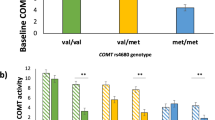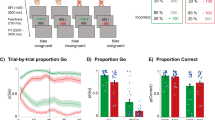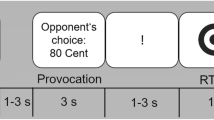Abstract
Whether to continue to exploit a source of reward, or to search for a new one of potentially greater value, is a fundamental and underconstrained decision. Recent computational studies of this exploration-exploitation tradeoff have found that variability in exploration across individuals is influenced by a functional polymorphism (Val158Met) in the catechol-O-methyltransferase (COMT) gene, whose protein product degrades synaptically released dopamine. However, these and other genotype–phenotype associations have rarely been causally tested. To directly test this association and to evaluate additional behavioral characteristics, including perceived locus of control (LOC), here we used the COMT inhibitor tolcapone in a randomized, double-blind, counterbalanced, within-subject study of 66 subjects genotyped for the Val158Met allele to assess the hypothesis that reducing COMT enzymatic activity interacts with genotype to increase uncertainty-driven exploration. In keeping with our initial hypothesis, tolcapone led to an increase in exploratory, but not exploitative, behavior in Met/Met rather than Val/Val subjects. Independent of genotype, those subjects with a more external LOC also showed increases in uncertainty-driven exploration on tolcapone relative to placebo. However, we did not replicate our previous finding that Met/Met subjects show greater exploration at baseline. Together these findings support a model in which exploration is hypothesized to have a dopaminergic basis. Moreover, in keeping with findings in other behavioral and cognitive domains, the response to an increase in presumptively frontal dopamine is dependent upon baseline dopamine tone.
Similar content being viewed by others
Log in or create a free account to read this content
Gain free access to this article, as well as selected content from this journal and more on nature.com
or
References
Apud JA, Mattay V, Chen J, Kolachana BS, Callicott JH, Rasetti R et al (2007). Tolcapone improves cognition and cortical information processing in normal human subjects. Neuropsychopharmacology 32: 1011–1020.
Badre D, Doll BB, Long NM, Frank MJ (2012). Rostrolateral prefrontal cortex and individual differences in uncertainty-driven exploration. Neuron 73: 595–607.
Cavanagh JF, Figueroa CM, Cohen MX, Frank MJ (2012). Frontal theta reflects uncertainty and unexpectedness during exploration and exploitation. Cereb Cortex 22: 2575–2586.
Ceravolo R, Piccini P, Bailey DL, Jorga KM, Bryson H, Brooks DJ (2002). 18F-dopa PET evidence that tolcapone acts as a central COMT inhibitor in Parkinson's disease. Synapse 43: 201–207.
Chen J, Lipska BK, Halim N, Ma QD, Matsumoto M, Melhem S et al (2004). Functional analysis of genetic variation in catechol-O-methyltransferase (COMT): effects on mRNA, protein, and enzyme activity in postmortem human brain. Am J Hum Genet 75: 807–821.
Collins AG, Frank MJ (2014). Opponent Actor Learning (OpAL): modeling interactive effects of striatal dopamine on reinforcement learning and choice incentive. Psychol Rev 121: 337–366.
Cools R, D'Esposito M (2011). Inverted-U-shaped dopamine actions on human working memory and cognitive control. Biol Psychiatry 69: e113–e125.
Daw ND, O'Doherty JP, Dayan P, Seymour B, Dolan RJ (2006). Cortical substrates for exploratory decisions in humans. Nature 441: 876–879.
De Brabander B, Declerck CH (2004). A possible role of central dopamine metabolism associated with individual differences in locus of control. Personality and Individual Differences 37: 735–750.
Declerck CH, Boone C, De Brabander B (2006). On feeling in control: a biological theory for individual differences in control perception. Brain Cogn 62: 143–176.
Dumontheil I, Burgess PW, Blakemore SJ (2008). Development of rostral prefrontal cortex and cognitive and behavioural disorders. Dev Med Child Neurol 50: 168–181.
Frank MJ, Doll BB, Oas-Terpstra J, Moreno F (2009). Prefrontal and striatal dopaminergic genes predict individual differences in exploration and exploitation. Nat Neurosci 12: 1062–1068.
Frank MJ, Fossella JA (2011). Neurogenetics and pharmacology of learning, motivation, and cognition. Neuropsychopharmacology 36: 133–152.
Gogos JA, Morgan M, Luine V, Santha M, Ogawa S, Pfaff D et al (1998). Catechol-O-methyltransferase-deficient mice exhibit sexually dimorphic changes in catecholamine levels and behavior. Proc Natl Acad Sci USA 95: 9991–9996.
Kalidindi K, Bowman H (2007). Using epsilon-greedy reinforcement learning methods to further understand ventromedial prefrontal patients' deficits on the Iowa Gambling Task. Neural Netw 20: 676–689.
Kayser AS, Allen DC, Navarro-Cebrian A, Mitchell JM, Fields HL (2012). Dopamine, corticostriatal connectivity, and intertemporal choice. J Neurosci 32: 9402–9409.
Kimberg DY, D'Esposito M, Farah MJ (1997). Effects of bromocriptine on human subjects depend on working memory capacity. Neuroreport 8: 3581–3585.
Maia TV, Frank MJ (2011). From reinforcement learning models to psychiatric and neurological disorders. Nat Neurosci 14: 154–162.
Mitchell JM, Fields HL, D'Esposito M, Boettiger CA (2005). Impulsive responding in alcoholics. Alcohol Clin Exp Res 29: 2158–2169.
Moustafa AA, Cohen MX, Sherman SJ, Frank MJ (2008). A role for dopamine in temporal decision making and reward maximization in parkinsonism. J Neurosci 28: 12294–12304.
Patton JH, Stanford MS, Barratt ES (1995). Factor structure of the Barratt impulsiveness scale. J Clin Psychol 51: 768–774.
Ramnani N, Owen AM (2004). Anterior prefrontal cortex: insights into function from anatomy and neuroimaging. Nat Rev Neurosci 5: 184–194.
Rotter JB (1966). Generalized expectancies for internal versus external control of reinforcement. Psychol Monogr 80: 1–28.
Smith CT, Boettiger CA (2012). Age modulates the effect of COMT genotype on delay discounting behavior. Psychopharmacology (Berl) 222: 609–617.
Spielberger CD (1983) Manual for the state-trait anxiety inventory. Consulting Psychologists Press.
Stelzel C, Basten U, Montag C, Reuter M, Fiebach CJ (2009). Effects of dopamine-related gene-gene interactions on working memory component processes. Eur J Neurosci 29: 1056–1063.
Strauss GP, Frank MJ, Waltz JA, Kasanova Z, Herbener ES, Gold JM (2011). Deficits in positive reinforcement learning and uncertainty-driven exploration are associated with distinct aspects of negative symptoms in schizophrenia. Biol Psychiatry 69: 424–431.
Vytlacil J, Kayser A, Miyakawa A, D'Esposito M (2014). An approach for identifying brainstem dopaminergic pathways using resting state functional MRI. PLoS One 9: e87109.
Acknowledgements
We thank Candice Teague for essential help with subject screening, and the subjects themselves for their participation. This research was supported by funding from the Wheeler Center for the Neurobiology of Addiction, the Telemedicine and Advanced Technology Research Center (grants W81XWH-10-1-0231 and W81XWH-11-1-0596 to A.S.K. and J.M.M.) and funds from the state of California (A.S.K. and J.M.M.).
Author information
Authors and Affiliations
Corresponding author
Additional information
Supplementary Information accompanies the paper on the Neuropsychopharmacology website
Rights and permissions
About this article
Cite this article
Kayser, A., Mitchell, J., Weinstein, D. et al. Dopamine, Locus of Control, and the Exploration-Exploitation Tradeoff. Neuropsychopharmacol 40, 454–462 (2015). https://doi.org/10.1038/npp.2014.193
Received:
Revised:
Accepted:
Published:
Issue date:
DOI: https://doi.org/10.1038/npp.2014.193
This article is cited by
-
Disentangling the roles of dopamine and noradrenaline in the exploration-exploitation tradeoff during human decision-making
Neuropsychopharmacology (2023)
-
Neuromodulation of prefrontal cortex cognitive function in primates: the powerful roles of monoamines and acetylcholine
Neuropsychopharmacology (2022)
-
A neural and behavioral trade-off between value and uncertainty underlies exploratory decisions in normative anxiety
Molecular Psychiatry (2022)
-
Working memory, cortical dopamine tone, and frontoparietal brain recruitment in post-traumatic stress disorder: a randomized controlled trial
Translational Psychiatry (2021)
-
The catechol-O-methyltransferase inhibitor tolcapone modulates alcohol consumption and impulsive choice in alcohol use disorder
Psychopharmacology (2020)



